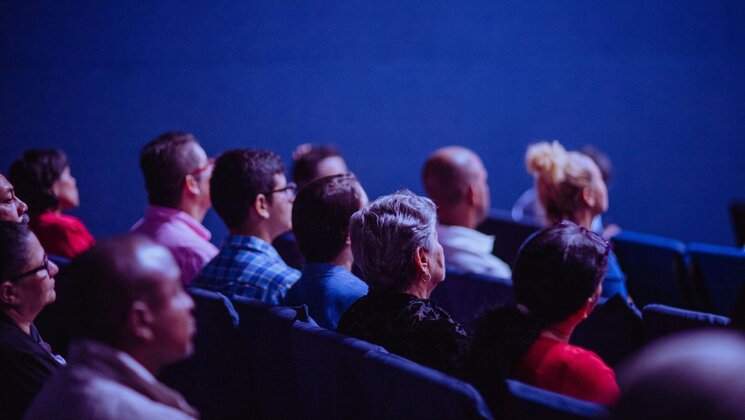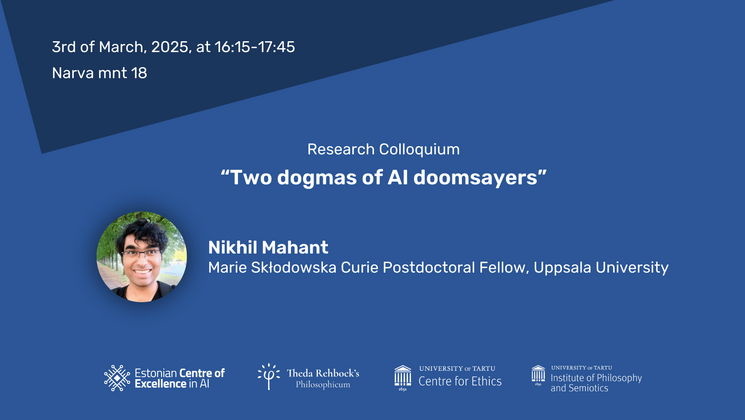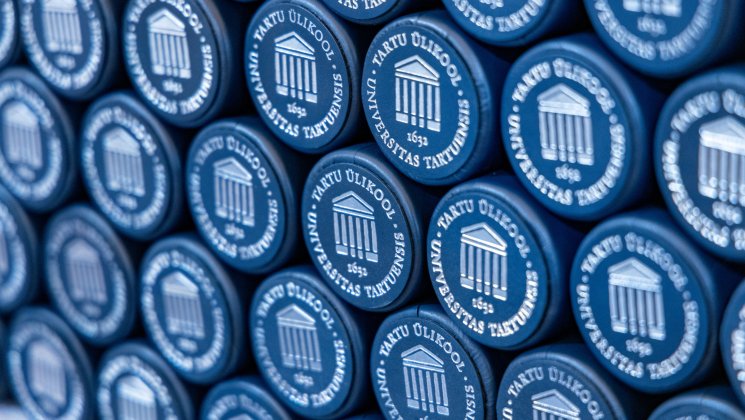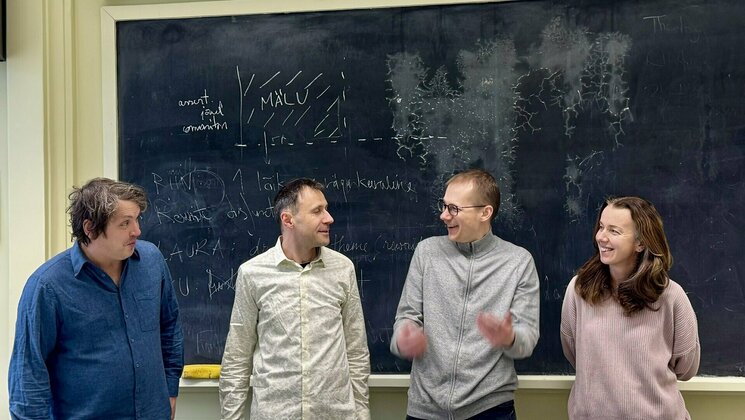-
Faculty of Arts and HumanitiesDean's Office, Faculty of Arts and HumanitiesJakobi 2, r 116-121 51005 Tartu linn, Tartu linn, Tartumaa EST0Institute of History and ArchaeologyJakobi 2 51005 Tartu linn, Tartu linn, Tartumaa EST0Institute of Estonian and General LinguisticsJakobi 2, IV korrus 51005 Tartu linn, Tartu linn, Tartumaa EST0Institute of Philosophy and SemioticsJakobi 2, III korrus, ruumid 302-337 51005 Tartu linn, Tartu linn, Tartumaa EST0Institute of Cultural ResearchÜlikooli 16 51003 Tartu linn, Tartu linn, Tartumaa EST0Institute of Foreign Languages and CulturesLossi 3 51003 Tartu linn, Tartu linn, Tartumaa EST0School of Theology and Religious StudiesÜlikooli 18 50090 Tartu linn, Tartu linn, Tartumaa EST0Viljandi Culture AcademyPosti 1 71004 Viljandi linn, Viljandimaa EST0Professors emeriti, Faculty of Arts and Humanities0Associate Professors emeriti, Faculty of Arts and Humanities0Faculty of Social SciencesDean's Office, Faculty of Social SciencesLossi 36 51003 Tartu linn, Tartu linn, Tartumaa EST0Institute of EducationJakobi 5 51005 Tartu linn, Tartu linn, Tartumaa EST0Johan Skytte Institute of Political StudiesLossi 36, ruum 301 51003 Tartu linn, Tartu linn, Tartumaa EST0School of Economics and Business AdministrationNarva mnt 18 51009 Tartu linn, Tartu linn, Tartumaa EST0Institute of PsychologyNäituse 2 50409 Tartu linn, Tartu linn, Tartumaa EST0School of LawNäituse 20 - 324 50409 Tartu linn, Tartu linn, Tartumaa EST0Institute of Social StudiesLossi 36 51003 Tartu linn, Tartu linn, Tartumaa EST0Narva CollegeRaekoja plats 2 20307 Narva linn, Ida-Virumaa EST0Pärnu CollegeRingi 35 80012 Pärnu linn, Pärnu linn, Pärnumaa EST0Professors emeriti, Faculty of Social Sciences0Associate Professors emeriti, Faculty of Social Sciences0Faculty of MedicineDean's Office, Faculty of MedicineRavila 19 50411 Tartu linn, Tartu linn, Tartumaa ESTInstitute of Biomedicine and Translational MedicineBiomeedikum, Ravila 19 50411 Tartu linn, Tartu linn, Tartumaa ESTInstitute of PharmacyNooruse 1 50411 Tartu linn, Tartu linn, Tartumaa ESTInstitute of DentistryL. Puusepa 1a 50406 Tartu linn, Tartu linn, Tartumaa ESTInstitute of Clinical MedicineL. Puusepa 8 50406 Tartu linn, Tartu linn, Tartumaa ESTInstitute of Family Medicine and Public HealthRavila 19 50411 Tartu linn, Tartu linn, Tartumaa ESTInstitute of Sport Sciences and PhysiotherapyUjula 4 51008 Tartu linn, Tartu linn, Tartumaa ESTProfessors emeriti, Faculty of Medicine0Associate Professors emeriti, Faculty of Medicine0Faculty of Science and TechnologyDean's Office, Faculty of Science and TechnologyVanemuise 46 - 208 51003 Tartu linn, Tartu linn, Tartumaa ESTInstitute of Computer ScienceNarva mnt 18 51009 Tartu linn, Tartu linn, Tartumaa ESTInstitute of GenomicsRiia 23b/2 51010 Tartu linn, Tartu linn, Tartumaa ESTEstonian Marine Institute0Institute of PhysicsInstitute of ChemistryRavila 14a 50411 Tartu linn, Tartu linn, Tartumaa EST0Institute of Mathematics and StatisticsNarva mnt 18 51009 Tartu linn, Tartu linn, Tartumaa EST0Institute of Molecular and Cell BiologyRiia 23, 23b - 134 51010 Tartu linn, Tartu linn, Tartumaa ESTTartu ObservatoryObservatooriumi 1 61602 Tõravere alevik, Nõo vald, Tartumaa EST0Institute of TechnologyNooruse 1 50411 Tartu linn, Tartu linn, Tartumaa ESTInstitute of Ecology and Earth SciencesJ. Liivi tn 2 50409 Tartu linn, Tartu linn, Tartumaa ESTProfessors emeriti, Faculty of Science and Technology0Associate Professors emeriti, Faculty of Science and Technology0Institute of BioengineeringArea of Academic SecretaryHuman Resources OfficeUppsala 6, Lossi 36 51003 Tartu linn, Tartu linn, Tartumaa EST0Area of Head of FinanceFinance Office0Area of Director of AdministrationInformation Technology Office0Administrative OfficeÜlikooli 17 (III korrus) 51005 Tartu linn, Tartu linn, Tartumaa EST0Estates Office0Marketing and Communication OfficeÜlikooli 18, ruumid 102, 104, 209, 210 50090 Tartu linn, Tartu linn, Tartumaa EST0Area of RectorRector's Strategy OfficeInternal Audit OfficeArea of Vice Rector for Academic AffairsOffice of Academic AffairsUniversity of Tartu Youth AcademyUppsala 10 51003 Tartu linn, Tartu linn, Tartumaa EST0Student Union OfficeÜlikooli 18b 51005 Tartu linn, Tartu linn, Tartumaa EST0Centre for Learning and TeachingArea of Vice Rector for ResearchUniversity of Tartu LibraryW. Struve 1 50091 Tartu linn, Tartu linn, Tartumaa EST0Grant OfficeArea of Vice Rector for DevelopmentCentre for Entrepreneurship and InnovationNarva mnt 18 51009 Tartu linn, Tartu linn, Tartumaa EST0University of Tartu Natural History Museum and Botanical GardenVanemuise 46 51003 Tartu linn, Tartu linn, Tartumaa EST0International Cooperation and Protocol Office0University of Tartu MuseumLossi 25 51003 Tartu linn, Tartu linn, Tartumaa EST0
Lectures by Kay O'Halloran and Donald Favareau
Dear friends in semiotics,
Please join us at the next meeting in the Juri Lotman and Jakob von Uexküll lectures series on December 20 at 2.15 pm in Jakobi 2-336.
The presenters are Kay O'Halloran (University of Liverpool) and Donald Favareau (Singapore State University).
Hope to meet you all!
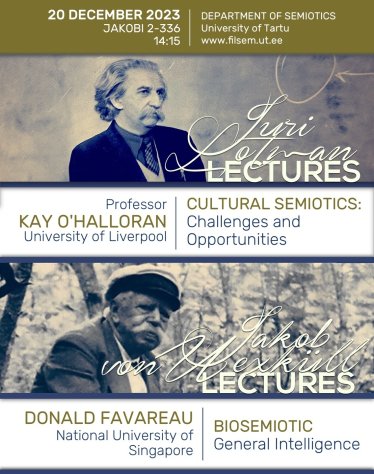
Kay O'Halloran: Cultural Semiotics: Challenges and Opportunities
In this talk, I explore the role of cultural semiotics today. Specifically, I examine the challenges arising from the power, knowledge, and wealth generated from semiotic data by the large technology companies. I will examine the recent developments in digital technology and AI, with a view to understanding the functions of the current digital ecosystem and the semiosphere which results. This includes discussion of how semiotic data is collected and analysed topredict and control human behaviour, resulting in the “unauthorised privatization of the division of learning in society today” (Zuboff, 2019: 192). As Zuboff further explains: “technology only contributes to shared prosperity when it is tamed by democratic rights, values, principles, and the laws that sustain them in our daily lives” (preface to Acemoglu & Johnson 2023). Within this context, I examine the role of cultural semiotics in shaping the future.
References:
Acemoglu, D & Johnson, S. (2023). Power and Progress: Our Thousand-Year Struggle Over Technology and Prosperity. London: Basic Books.
O’Halloran, K. L. (2023). Meaning, Matter and Semiotics. Visual Communication, 22(1). Special Issue: 20 Years of Visual Communication, edited by Louise Ravelli, Janina Wildfeuer et al.
Zuboff, S. (2019). The Age of Surveillance Capitalism: The Fight for a Human Future at the New Frontier of Power. New York: Public Affairs.
Don Favareau: Biosemiotic General Intelligence
After a brief period in which the early “machine learning” dream of eventually developing a human-like and even super-human-like, Artificial General Intelligence (AGI) was more or less put to rest, and subsumed by the development of more targeted and less ambitious computational and robotic technologies, with the global release of Generative Pre-Trained Transformer based software such as Chat GPT and DALL-E to the public “in 2023, everything changed” in the both the professional and in the public discourses surrounding Artificial Intelligence in general, and AGI in particular, as Audi Viidalepp reveals so cogently in her recent doctoral dissertation, The Expected AI as a Sociocultural Construct and its Impact on the Discourse on Technology (2023).
As Viidalepp shows, such discourse “is saturated with reified metaphors [of anthropomorphism and technological determinism] which drive connotations and delimit understandings of technology in society” (2023: 13). Too, along with reviving ancient fears, hopes and debates on the role of “technology” in the lives of human beings, the current discourse surrounding these technologies once again makes salient the foundational biosemiotic question of “How are we to understand the nature of an ‘intelligent’ system per se?” Is it the result of algorithmic computation and stochastic probability functioning? The “imprinting of meaning” via the creation of embodied and enacted “functional circles” in an otherwise unlabeled world? Or the navigation of co-ordinates within a cultural (or even natural) matrix of possibility, actuality and lawfulness, as described by Peircean triadic sign logic?
Such questions have always been, and remain, at the heart of the biosemiotic research agenda, and in this talk, I will take the opportunity to reflect a bit on the implications that a serious consideration of the biosemiotic perspective on organismic intelligence might bring to the current discourse surrounding the possibilities and perils of AI and AGI, as they are currently conceived.
References:
Favareau, Donald and Kull, Kalevi (in press). Conceptualizing the Role of Signs and Meanings in the Biosphere: Historical and Contemporary Perspectives. Pathways to the Origin and Evolution of Meanings in the Universe. Sharov. A., Gordon, R., Mikhailovsky, G. and Seckbach, J. (Eds). Austin: Scrivner.
Peirce, Charles Sanders. (1857-1914[1931-1935; 1958]). Collected Papers of Charles Sanders Peirce, Volumes 1-8. Harvard University Press, Cambridge, MA.
Uexküll, Jakob von. (1926 [1928]). Theoretical Biology. D.L. Mackinnon (trans). Kegan Paul, London.
Viidalepp, Auli. (2023). The Expected AI as a Sociocultural Construct and its Impact on the Discourse on Technology. Tartu: Tartu University Press.
Read more similar news



